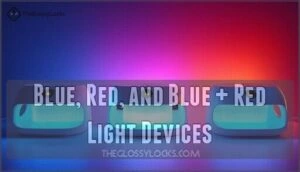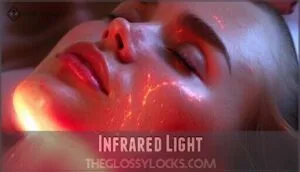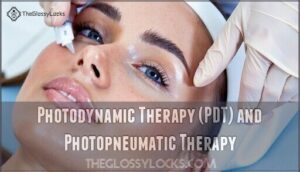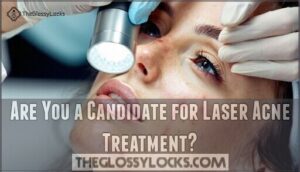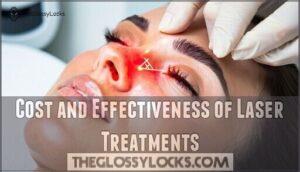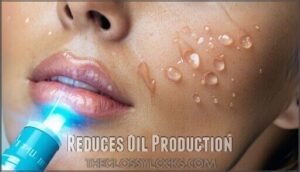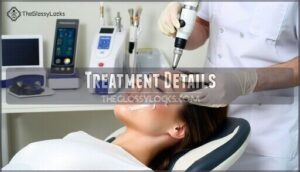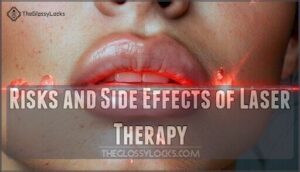This site is supported by our readers. We may earn a commission, at no cost to you, if you purchase through links.
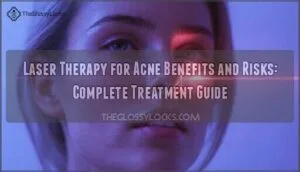
You’ll experience moderate improvement in acne severity, though results vary substantially between individuals. Most people need multiple sessions combined with topical medications for the best outcomes.
Common side effects include temporary redness, swelling, and mild discomfort that typically resolve within days.
However, you should be aware that serious complications like scarring or pigmentation changes can occur, especially with darker skin tones. The treatment isn’t suitable for everyone, particularly those with active infections or certain medical conditions.
Understanding these factors helps you make informed decisions about whether this approach aligns with your skin goals.
Table Of Contents
- Key Takeaways
- Laser Therapy for Acne
- Types of Lasers and Lights Used
- Are You a Candidate for Laser Acne Treatment?
- Cost and Effectiveness of Laser Treatments
- How Laser Therapy Works for Acne
- Risks and Side Effects of Laser Therapy
- Frequently Asked Questions (FAQs)
- Is laser therapy for acne safe?
- Are there any side effects of laser treatment for acne?
- What are the disadvantages of laser therapy?
- Is laser treatment for acne harmful?
- How effective are laser treatments for acne?
- What are the side effects of laser treatment for acne scars?
- Can a laser treatment treat acne vulgaris?
- Is laser treatment for acne safe?
- What are the disadvantages of laser treatment for the face?
- Is there any risk in laser treatment?
- Conclusion
Key Takeaways
- You’ll achieve moderate results with laser therapy, seeing 36-86% acne clearance rates rather than complete elimination, especially when combined with topical treatments.
- You can expect temporary side effects like redness, swelling, and peeling that typically resolve within days, though darker skin tones face higher risks of pigmentation changes.
- You’ll need multiple sessions (3-6 treatments) spaced weeks apart, with total costs ranging from $600-$1,500 for complete treatment that isn’t covered by insurance.
- You must consult a dermatologist first since laser therapy isn’t suitable for everyone, particularly those with active infections, certain medications, or pregnancy.
Laser Therapy for Acne
If you’re struggling with persistent acne that hasn’t responded to traditional treatments, laser therapy might offer the breakthrough you need.
This advanced treatment uses focused light energy to target acne-causing bacteria, reduce inflammation, and minimize oil production beneath your skin’s surface, which can lead to a significant improvement in acne symptoms through advanced treatment.
How Well Do Lasers Treat Acne
When you undergo laser acne treatment, you’ll see moderate results – studies show 36-86% acne clearance rates, though complete elimination is rare.
Most patients achieve partial acne improvement with laser therapy, not complete clearance.
Skin tone impact matters; lighter complexions respond better than darker ones.
Combination therapies boost effectiveness substantially, and treatment duration spans 3-6 sessions over several months.
Long-term efficacy varies, with some patients maintaining improvements for up to one year after completing their laser treatment protocol.
What to Expect From Laser and Light Treatments
Most people see gradual improvement with laser acne treatment, but complete clearing isn’t guaranteed.
Your treatment timeline typically spans 3-6 sessions spaced weeks apart. Session preparation involves avoiding sun exposure and certain skincare products.
Immediate aftercare includes gentle moisturizing and sun protection. Downtime details are minimal—expect mild redness lasting days.
Expected improvements become visible after multiple treatments, with laser therapy benefits lasting months, providing a noticeable complete clearing of acne.
Potential Side Effects
Understanding what can happen after laser treatment helps you make informed decisions about your acne care.
Laser therapy gives you the power to make informed choices about your acne treatment journey.
Most laser treatment side effects are temporary and manageable, but knowing what’s normal keeps you prepared.
Common reactions include:
- Redness and swelling typically fade within days, similar to mild sunburn
- Hyperpigmentation or darkening of the skin may occur, especially in darker skin tones
- Blistering and bruising can develop with stronger laser settings
- Premature aging concerns exist with repeated treatments affecting oil glands.
Serious laser treatment risks like permanent damage remain rare when you follow proper aftercare.
Most people experience only mild discomfort that resolves quickly, making the benefits worth the temporary inconvenience.
Patient Responsibilities
Your success depends on thorough Pre-Treatment Prep and Post-Care Adherence. Follow your dermatologist’s skincare routine instructions precisely.
Maintain strict Sun Protection with daily sunscreen application. Practice Product Avoidance by skipping harsh treatments during therapy. Minimize sun exposure throughout treatment.
Attend all Follow-up Appointments for progress monitoring. Proper postlaser care and treatment followup guarantee outstanding results and minimize complications.
Selecting the right sunscreen for acne is vital during acne treatment.
Types of Lasers and Lights Used
Several laser and light technologies target acne through different mechanisms, each with specific wavelengths and applications.
You’ll encounter blue light devices that kill bacteria, red light systems that reduce inflammation, infrared lasers that penetrate deeper skin layers, and specialized therapies like PDT that combine light with medication.
Blue, Red, and Blue + Red Light Devices
Several light therapy devices target different layers of your skin to fight acne bacteria and inflammation.
Blue light therapy penetrates surface layers, destroying acne bacteria through bacterial targeting of P. acnes organisms.
Red light therapy goes deeper, offering inflammation reduction and tissue repair through enhanced light penetration.
Combination efficacy shines when blue and red wavelengths work together—studies show 77% improvement in inflammatory lesions.
The device portability of at-home LED units makes daily treatment convenient, though they’re less powerful than professional devices.
These targeted wavelengths offer a gentler approach to clearing stubborn breakouts without harsh chemicals.
This approach is considered a drug-free acne treatment without harsh side effects.
Infrared Light
While blue and red light target surface-level bacteria, infrared light takes a different approach through Infrared Penetration into deeper skin layers.
This acne laser therapy uses wavelengths like 1320nm and 1450nm to create photothermal effects that shrink sebaceous glands and reduce oil production.
Laser treatment benefits include targeting inflammation where it starts – beneath the surface. You’ll see gradual improvements over 4-8 weeks as infrared promotes Deeper Healing and Collagen Stimulation.
Studies show up to 57% reduction in inflammatory lesions with infrared lasers. Low-level laser therapy can also reduce sebum secretion, as shown in clinical acne studies.
Key advantages of acne vulgaris treatment with infrared:
- Penetrates deeper than blue/red light for thorough laser therapy
- Reduces inflammation by lowering cytokine levels (IL-α, TNF-α)
- Promotes Skin Rejuvenation through enhanced blood circulation
- Supports Scar Reduction via increased collagen production
- Safe for most skin types with minimal side effects
This approach works best when combined with other treatments rather than as standalone laser therapy.
Photodynamic Therapy (PDT) and Photopneumatic Therapy
Photodynamic therapy transforms your acne treatment approach through light sensitivity mechanisms.
PDT requires applying photosensitizing solutions before targeted light exposure, achieving partial clinical response in 50% of cases across extensive studies.
Photopneumatic therapy combines gentle vacuum extraction with IPL technology, delivering 69% reduction in inflamed lesions.
For more information, you can explore PDT acne products.
These combination therapies offer treatment durability lasting several months, making acne laser therapy particularly effective for severe, treatment-resistant cases requiring thorough acne inflammation reduction strategies.
Are You a Candidate for Laser Acne Treatment?
Not everyone’s a good candidate for laser acne treatment, and certain medical conditions or medications can make the procedure risky.
You’ll need a dermatologist’s evaluation to determine if laser therapy suits your specific skin type, acne severity, and medical history.
Good Candidates
You’re an ideal candidate if you have mild to moderate inflammatory acne and healthy skin phototypes on the Fitzpatrick scale.
Your acne severity, skin tone, and treatment goals guide laser selection.
Consider your health history, especially cold sores, and scarring type.
Most candidates combine laser therapy with topical treatments for desired results.
Contraindications
Before diving into treatment, it’s essential to understand who shouldn’t undergo laser therapy.
Certain skin conditions, pregnancy concerns, and medication interactions create significant treatment risks that outweigh potential laser treatment benefits.
- Pregnancy and breastfeeding – Absolute contraindications due to unknown effects on fetal development
- Photosensitizing medications – Including isotretinoin (6-month waiting period), doxycycline, and chemotherapy agents
- Active skin conditions – Herpes simplex, open wounds, severe rosacea, or bacterial infections in treatment areas
- Recent sun exposure – Sunburn or excessive tanning increases keloid formation risk and hyperpigmentation complications
Laser treatment caution is especially important for darker skin tones and those with autoimmune disorders requiring medical clearance.
Importance of Consulting a Dermatologist
Consulting a dermatologist isn’t optional—it’s your safety net.
They’ll assess your Skin Type and perform thorough Risk Assessment to determine if you’re a good candidate.
A qualified dermatologist creates Personalized Treatment plans adapted to your specific acne severity and skin concerns.
They’ll explain realistic benefits and risks, plus provide detailed Aftercare Guidance.
This consultation helps set Realistic Expectations about what laser treatment can actually achieve for your unique situation, preventing disappointment and potential complications down the road.
Cost and Effectiveness of Laser Treatments
Understanding laser treatment costs helps you make informed decisions about your acne care investment.
Most patients pay between $600-$1,500 total for complete treatment, though effectiveness varies based on your specific skin type and acne severity.
Average Cost of Laser Treatments for Acne
When you’re considering laser treatment cost for acne, you’ll face expenses that can stretch from $200 to $3,000 per session.
The American Society of Plastic Surgeons reports average costs of $1,829 for laser skin resurfacing, while non-ablative treatments average $1,815 and ablative procedures reach $2,809 per session.
Here’s what you can expect for different laser types:
- Fraxel treatments: $900-$1,500 for full-face or $250-$500 for targeted spots
- CO₂ laser resurfacing: $1,000-$5,000 per session for extensive facial treatment
- Non-ablative options: $300-$1,500 per session with gentler recovery
- Blue/red light therapy: FDA-approved home devices available at lower costs
Treatment packages often provide 10-20% discounts when you commit to multiple sessions.
Most patients need 2-5 treatments for ideal laser treatment effectiveness, potentially reaching $10,000 total.
Insurance coverage remains unlikely since acne treatment is typically classified as cosmetic.
However, many clinics offer financing options to help manage costs.
Factors Affecting Cost
Several factors determine your laser treatment cost beyond the basic session price.
Acne severity directly impacts the number of sessions required – mild cases might need 3-4 treatments while severe acne could require 6-8 sessions.
Provider fees vary substantially based on dermatologist experience and geographic location.
Most insurance coverage excludes cosmetic laser procedures, though some package deals offer discounted rates for multiple sessions, potentially reducing overall laser treatment cost.
Moderate Effectiveness
Laser therapy shows moderate effectiveness for acne treatment, with studies demonstrating 36-86% partial clearance rates rather than complete elimination.
Results vary substantially based on skin tone, with lighter complexions responding better.
Combined treatments with topical medications typically outperform laser therapy alone.
Benefits include sebum reduction and anti-inflammatory effects, often producing lasting results up to one year post-treatment.
Notably, low level laser therapy is also used to stimulate hair growth.
Limitations of Studies
Research quality varies substantially when you’re evaluating laser acne treatments.
Current clinical studies face several methodological challenges that affect how confidently you can interpret results:
- Sample Size limitations reduce statistical power in many trials
- Skin Tone representation remains inadequate across diverse populations
- Long Term follow-up data is often missing from efficacy assessments
- Treatment Combination variables aren’t consistently controlled between studies
Subjectivity Bias in systematic reviews also affects methodological quality, making it harder to determine true safety profiles.
How Laser Therapy Works for Acne
Laser therapy targets acne through three primary mechanisms that address the underlying causes of breakouts.
The focused light energy penetrates your skin to destroy acne-causing bacteria, reduce sebaceous gland activity, and calm inflammatory responses.
Targets Bacteria
Blue and red light work like precision-guided weapons against Cutibacterium acnes bacteria.
When laser therapy targets these microorganisms, the light spectrum activates porphyrins within bacterial walls, creating fatal damage through bacterial reduction.
This acne prevention method destroys harmful bacteria without affecting healthy skin cells.
Treatment combinations enhance effectiveness while addressing resistance concerns that traditional antibiotics face.
Reduces Oil Production
Beyond targeting bacteria, laser therapy shrinks your skin oil glands to reduce sebum production.
This Sebum Reduction Rate varies based on Laser Parameter Impact and Treatment Duration Effect.
Smaller Sebaceous Gland Size means less skin oil production, helping prevent clogged pores that cause acne.
Studies show Long-Term Control of oil levels lasting months after treatment completion.
Anti-inflammatory Properties
While laser therapy reduces oil production, it simultaneously tackles another root cause of acne: inflammation.
This powerful anti-inflammatory action works at the cellular level through cytokine modulation, helping calm angry, inflamed skin.
You’ll notice significant redness reduction and swelling mitigation as the treatment promotes tissue repair and healing acceleration.
To further soothe the skin, consider aloe vera application for its cooling properties.
Key anti-inflammatory benefits include:
- Redness Reduction – Minimizes visible inflammation and irritation
- Swelling Mitigation – Decreases puffiness around active breakouts
- Tissue Repair – Stimulates natural healing processes
- Healing Acceleration – Speeds recovery time for existing lesions
Treatment Details
Most doctors recommend three Multiple Sessions spaced monthly apart, though Session Duration varies by individual needs.
Your provider applies Numbing Cream before targeting problem areas with types of acne lasers like ablative laser treatment or nonablative laser options.
Laser skin resurfacing procedures typically last 30-60 minutes with Downtime Minimal afterward.
Proper Post-Care and following laser treatment recovery guidelines guarantee the best results.
Risks and Side Effects of Laser Therapy
While laser therapy offers significant benefits for acne treatment, you should understand the potential risks before starting treatment.
Most side effects are temporary and manageable, but knowing what to expect helps you make an informed decision about your care, and be aware of the potential risks.
Transient Side Effects
Most laser treatment recovery involves transient side effects that resolve within days to weeks.
You’ll likely experience redness duration of 1-3 days, mild swelling management needs, and peeling intensity that’s manageable.
Sun sensitivity increases temporarily, requiring diligent protection.
Darker skin tones may experience post-inflammatory hyperpigmentation, a common concern.
Proper aftercare prevents blistering prevention concerns and minimizes bruising or temporary darkening of the skin.
Common Side Effects
Most patients experience manageable side effects after laser acne treatments, though understanding these reactions helps you prepare for the healing process.
Your skin’s response varies based on laser intensity, treatment area, and individual sensitivity levels.
Here are the four most common side effects you’ll likely encounter:
- Redness and Swelling: Expect your treated skin to appear flushed and slightly puffy for 2-5 days post-treatment, similar to a mild sunburn reaction.
- Peeling and Dryness: Your skin will naturally shed damaged cells, creating temporary flaking that resolves within one week with proper moisturizing.
- Pigment Changes: Temporary darkening of the skin may occur, particularly in patients with darker complexions, though this typically fades over several weeks.
- Blistering: Small fluid-filled bumps occasionally develop in sensitive areas, requiring gentle care to prevent secondary infection risks.
Additional side effects include mild bruising around treatment sites and temporary inflammation.
Most reactions resolve independently without intervention, though persistent symptoms warrant dermatologist consultation to minimize scarring risk.
Severity Varies
Side effects’ intensity varies substantially between different laser therapy approaches and your unique skin condition.
Individual variation plays a vital role in treatment response, with some experiencing minimal discomfort while others face more pronounced reactions.
| Laser Type | Typical Side Effects |
|---|---|
| Blue/Red Light | Mild redness, temporary dryness |
| Infrared Lasers | Pain requiring topical anesthetic, deeper tissue effects |
| PDL/KTP Lasers | Bruising, temporary darkening (especially darker skin tones) |
Your acne severity and existing scarring differences directly influence how your skin responds to treatment, making personalized assessment essential before beginning acne scar removal procedures.
Long-term Concerns
While most side effects are temporary, understanding long-term concerns helps you make informed decisions about laser skin resurfacing for acne scar removal.
These potential complications, though uncommon, deserve careful consideration before treatment.
Pigmentation changes represent the most significant long-term risk, particularly for darker skin tones.
You might experience permanent lightening or darkening that persists for months or becomes irreversible.
Scarring potential exists with aggressive treatments, creating new marks instead of removing existing ones.
Premature aging can occur from gland damage affecting your skin’s natural oil production.
Increased skin sensitivity may leave you more vulnerable to sun damage and irritation.
- Permanent color changes affecting your natural skin tone
- Structural scarring from overly aggressive laser settings
- Oil gland damage disrupting normal skin function
- Heightened sensitivity requiring lifelong sun protection
Frequently Asked Questions (FAQs)
Is laser therapy for acne safe?
Studies show 36-86% acne clearance rates, making laser therapy generally safe with rare side effects.
You’ll experience minimal downtime, temporary redness, and possible peeling, but serious complications remain uncommon when performed professionally.
Are there any side effects of laser treatment for acne?
You’ll experience mild redness, swelling, and peeling after treatment—these reactions typically fade within days. Darker skin may temporarily darken, but serious complications remain uncommon with proper care.
What are the disadvantages of laser therapy?
Like walking a tightrope, laser therapy carries risks you’ll need to weigh.
You might experience temporary redness, swelling, hyperpigmentation, or blistering.
Costs aren’t covered by insurance, requiring multiple sessions for desirable results.
Is laser treatment for acne harmful?
Laser treatment for acne isn’t harmful when performed by qualified professionals. You’ll experience mild side effects like temporary redness and peeling, but serious complications are rare with proper care.
How effective are laser treatments for acne?
Acne laser treatments show 36-86% clearance rates, with fractional lasers delivering superior results. You’ll see 62-97% reduction in inflammatory lesions, lasting up to one year with proper care.
What are the side effects of laser treatment for acne scars?
You’ll typically notice temporary redness, swelling, and peeling after treatment. Darker skin may develop temporary darkening, while stronger lasers can cause blistering, bruising, or rare permanent scarring.
Can a laser treatment treat acne vulgaris?
Ironically, while acne seems impossible to control, you can actually target acne vulgaris effectively with laser treatments.
These focused light therapies reduce inflammatory lesions, destroy acne-causing bacteria, and decrease oil production for clearer skin.
Is laser treatment for acne safe?
Yes, laser treatment for acne is generally safe when performed by qualified professionals.
Side effects like redness and peeling are typically mild and temporary, with serious complications being rare when proper protocols are followed.
What are the disadvantages of laser treatment for the face?
Facial laser treatments carry several disadvantages you should consider.
You’ll face potential hyperpigmentation, temporary redness, skin sensitivity, and possible scarring.
Costs aren’t covered by insurance, requiring multiple expensive sessions for desirable results.
Is there any risk in laser treatment?
Laser treatments carry several risks you should consider before proceeding.
Common side effects include temporary redness, swelling, peeling, and increased sun sensitivity that’ll resolve within days.
More serious risks involve hyperpigmentation or hypopigmentation, particularly affecting darker skin tones.
Conclusion
Like a Swiss Army knife of dermatology treatments, laser therapy for acne benefits and risks represents a multifaceted approach to skin management.
You’ll find that this treatment option offers moderate effectiveness when combined with traditional therapies, though individual results vary substantially.
The procedure targets acne-causing bacteria while reducing inflammation, but you must weigh potential complications against expected benefits.
Consultation with a qualified dermatologist remains essential for determining candidacy and developing personalized treatment protocols that align with your specific skin type and acne severity.
- https://ijdvl.com/laser-and-light-based-treatments-of-acne/
- https://everestmedicalspa.com/med-spa-blog/what-are-the-side-effects-of-laser-acne-treatment
- https://pmc.ncbi.nlm.nih.gov/articles/PMC11438631/
- https://www.healthline.com/health/beauty-skin-care/laser-treatment-for-acne-scars
- https://www.ncbi.nlm.nih.gov/pubmed/27015782

